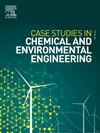Tunable copper based slag catalyst for energy vectors production
Q1 Environmental Science
Case Studies in Chemical and Environmental Engineering
Pub Date : 2024-12-06
DOI:10.1016/j.cscee.2024.101050
引用次数: 0
Abstract
Steel slag is known to contain various metal oxides and minerals that have the potential to function as green and sustainable catalysts for chemical reactions. Previous studies demonstrated that, albeit calcium aluminate is the major constituent, the presence of iron oxides enables the slag to function as photocatalyst for CO2 reduction reaction (CO2RR) to formic acid, and that doping with palladium improves these properties. In this new study, a novel and more versatile catalyst was prepared by functionalizing the slag with CuO nanostructures. The hybrid material (CuO-slag) was characterized by XRD, XPS, FESEM and SEM-EDX techniques, while electrochemical measurements certified its photocatalytic properties. Catalytic tests demonstrated that it is capable to convert CO2 into formic acid in good yields (231 μmol gcat-1 h-1), but also to push reduction reaction up to methanol (81.5 μmol gcat-1 h-1) and ethanol (40 μmol gcat-1 h-1), the latter under photo-thermal conditions. Finally, to further extend the scope of the hybrid material, the hydrogen evolution reaction (HER) was also investigated.

用于能量矢量生产的可调铜基渣催化剂
众所周知,钢渣含有各种金属氧化物和矿物质,这些金属氧化物和矿物质有可能成为绿色和可持续的化学反应催化剂。先前的研究表明,虽然铝酸钙是主要成分,但氧化铁的存在使渣作为CO2还原反应(CO2RR)到甲酸的光催化剂,而钯的掺杂改善了这些性能。在这项新的研究中,利用纳米CuO结构对炉渣进行功能化,制备了一种新的、更通用的催化剂。采用XRD、XPS、FESEM和SEM-EDX等技术对杂化材料进行了表征,并通过电化学测试验证了其光催化性能。催化实验表明,它能以231 μmol gcat-1 h-1的产率将CO2转化为甲酸,并能将还原反应提高到甲醇(81.5 μmol gcat-1 h-1)和乙醇(40 μmol gcat-1 h-1),后者在光热条件下进行。最后,为了进一步扩展杂化材料的范围,还研究了析氢反应(HER)。
本文章由计算机程序翻译,如有差异,请以英文原文为准。
求助全文
约1分钟内获得全文
求助全文
来源期刊

Case Studies in Chemical and Environmental Engineering
Engineering-Engineering (miscellaneous)
CiteScore
9.20
自引率
0.00%
发文量
103
审稿时长
40 days
 求助内容:
求助内容: 应助结果提醒方式:
应助结果提醒方式:


